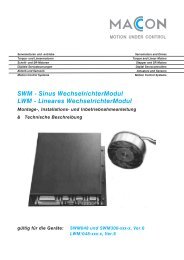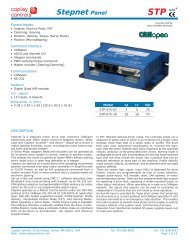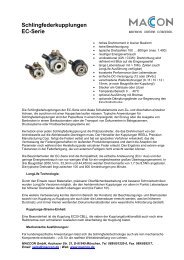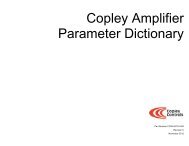CANopen Programmer's Manual - Maccon.de
CANopen Programmer's Manual - Maccon.de
CANopen Programmer's Manual - Maccon.de
Create successful ePaper yourself
Turn your PDF publications into a flip-book with our unique Google optimized e-Paper software.
1: Introduction <strong>CANopen</strong> Programmer’s <strong>Manual</strong><br />
How to Map (or Remap) a PDO<br />
Process Overview<br />
Two objects in the <strong>de</strong>vice’s object dictionary <strong>de</strong>fine a PDO:<br />
A PDO’s communication object <strong>de</strong>fines the PDO’s CAN message ID and its communication<br />
type (synchronous or asynchronous) and triggering type (event-drive or cyclic).<br />
A PDOs mapping object maps every data byte in the PDO message to an object in the<br />
<strong>de</strong>vice’s object dictionary.<br />
Mapping a PDO is the process of configuring the PDO’s communication and mapping objects.<br />
To Map a Receive PDO<br />
The general procedure for mapping a receive PDO follows. (The procedure for mapping a transmit<br />
PDO is similar).<br />
Stage Step Sub-steps/Comments<br />
1 Disable the PDO. In the PDO’s mapping object (Receive PDO Mapping Parameters, in<strong>de</strong>x<br />
0x1601), set the sub-in<strong>de</strong>x 0 (NUMBER OF MAPPED OBJECTS) to zero.<br />
This disables the PDO.<br />
2 Set the communication<br />
parameters.<br />
If necessary, set the PDO’s CAN message ID (PDO COB-ID) using subin<strong>de</strong>x<br />
1 of the PDO’s RECEIVE PDO Communication Parameters (in<strong>de</strong>x<br />
0x1401).<br />
Choose the PDO’s transmission type (PDO TYPE) in sub-in<strong>de</strong>x 2 of<br />
object 0x1401. A value in the range<br />
[0-240] = synchronous; [254-255] = asynchronous.<br />
3 Map the data. Using the PDO’s mapping parameters (sub-in<strong>de</strong>xes 1-4 of Receive PDO<br />
Mapping Parameters, in<strong>de</strong>x 0x1601), you can map up to 4 objects (whose<br />
contents must total to no more than 8 bytes), as follows:<br />
4. Set the number of mapped<br />
objects and enable the PDO.<br />
In bits 0-7 of the mapping value, enter the size (in bits) of the object to be<br />
mapped, as specified in the object dictionary.<br />
In bits 8-15, enter the sub-in<strong>de</strong>x of the object to be mapped. Clear bits 8-<br />
15 if the object is a simple variable.<br />
In bits 16-31, enter the in<strong>de</strong>x of the object to be mapped.<br />
In the PDO’s Receive PDO Mapping Parameters (in<strong>de</strong>x 0x1601), set subin<strong>de</strong>x<br />
0 (NUMBER OF MAPPED OBJECTS) to the actual number of<br />
objects mapped. This properly configures the PDO. Also, the presence of<br />
a non-zero value in the NUMBER OF MAPPED OBJECTS object enables<br />
the PDO.<br />
28 Copley Controls
















